I like to have a few colored pencils around for sketching, but I don’t usually use them alone. Rather, I combine them with watercolor to add texture and detail. I find colored pencils can often bring out certain fine details better and in a more controlled way than fiddling with fine brushes, and sometimes I use them instead of pencils for sketching – you have a wide selection of color and colored pencils give very smooth strokes, and they blend nicely into the rest of the sketch of you add color on top.
There are different kinds of colored pencils. All of them need binders for the pigments – some have more oil-based ingredients and some are wax-based. Most pencils use a mixture of binders. You can add water to some of them and spread the pigments around (watercolor pencils), and some will stay in place when you add water. I like to plan for these different qualities when I’m sketching. If I want to use colored pencils for line work that I want to be seen later, I use a pencil that’s not water-soluble. If I want it to disappear or merge with my painting, I’ll use water-soluble pencils (and sometimes I don’t think ahead and my drawing disppears when I add water).
Most typically I will use colored pencil as the last layer on top of watercolor, a lot of the details in my wildlife drawings (feathers, fur) can be done this way. Sometimes I use colored pencils for the very first layer to preserve details (how feathers are organized, patterns, etc.). I also like to add last touches to gouache or watercolor landscapes sketches with colored pencils – tree branches or grasses are also great to do in this technique. For me, the combination of thinking in value and color (painting) and thinking in line quality (drawing) can be achieved very well with colored pencil and watercolor. I usually don’t just get the standard rainbow colors that you get when buying a box (although these are useful too), but I often select single pencils with slightly more muted colors like light and dark browns, blues or greens. For nature sketching, you can never have too many greens and browns. Warm greys are also a good choice, I like to use grey colored pencils for drawing instead of regular pencils. Muted colors are also a great choice for making colored sketches, on white paper or on toned paper (light pencils let you add highlights).
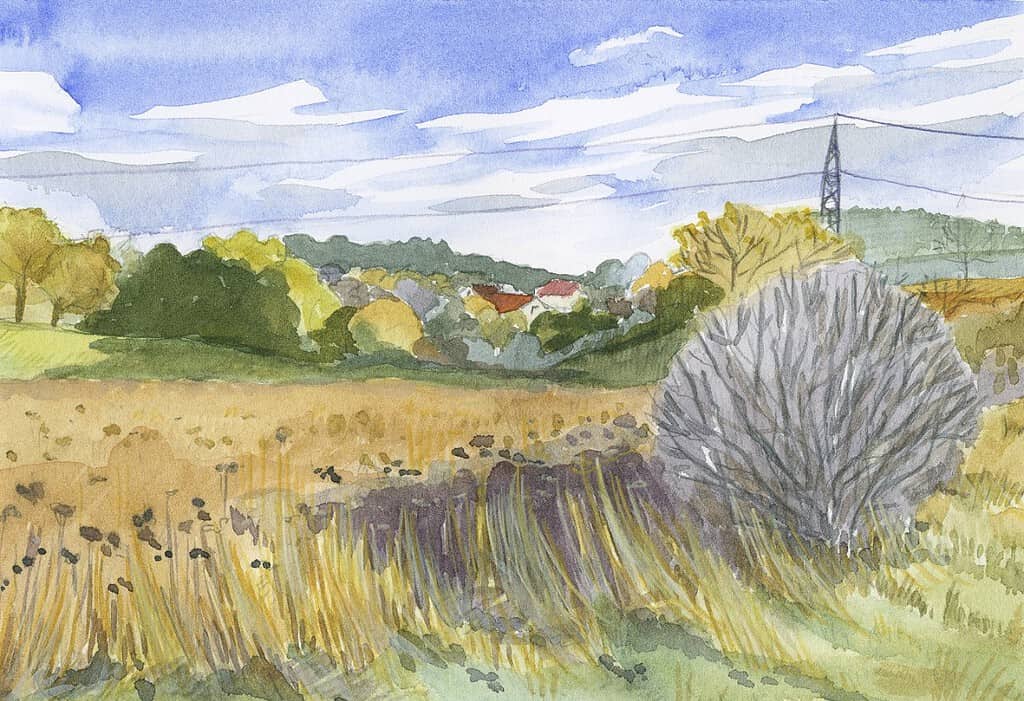
Lightfastness in colored pencils
As with all art supplies, I prefer to use materials that are reasonably lightfast if possible – although I work a lot in sketchbooks, I want to make sure I (or a customer who buys an original from me) can still see what I’ve drawn a couple of years from now. For colored pencils you usually don’t get pigment information, but the manufacturers at least tell you if the color is more or less lightfast. Testing methods and standards vary, and it can be very hard to get additional or in-depth information from customer service. Lightfastness is not as well documented as it is for most paints. Do ask the companies about this if you care about lightfastness, hopefully they will put out better information for all of us in the future. Pinks, purples and blues (and sometimes yellows) are most notorious and can fade really fast. Organizations like the CPSA (Colored Pencil Society of America) do their own independent testing, the results can differ from what the companies put on their labels. If you want to be sure, conduct your own tests.
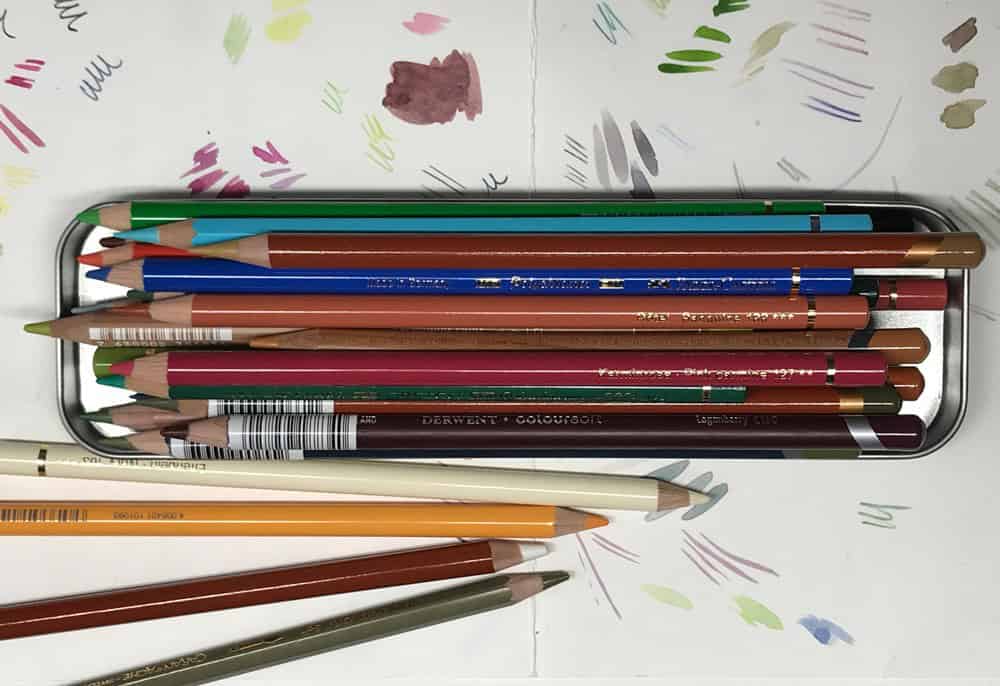
Lately, I’ve tried a few new brands of colored pencils and combined them with my standard colored pencils to see what’s out there on the market and what pencils I like to use on a regular basis. This is just a very personal overview that takes into account how I work with these pencils. These are the colored pencils I’ve worked with so far:
Faber-Castell Polychromos
These colored pencils are my standard choice. They are soft but don’t break even with a very pointy tip, there is a wide selection of colors available, and the lines stay where they are if you go over them with water. Great as an all-purpose colored pencil, and mostly lightfast. I really love these pencils and fortunately they’re easy to get for me and reasonably priced.
Faber-Castell Albrecht Dürer
These colored pencils are similar to the Polychromos (same company, same numbering system), but water-soluble. I don’t use that effect very often, and so I use them in the same way as the Polychromos. They are possibly a tiny bit less soft to draw with. Watercolour pencils (not only these ones) have often more less lightfast colors, so pay attention if this matters to you.
Faber-Castell also has a very nice customer support and answered a lot of my questions about lightfastness – I had a very nice conversation on the phone with the person who runs their lab. One thing I found very interesting that they mentioned is that lightfastness often doesn’t depend on the pigment alone, but how it’s combined with binders and what kind of bonds it forms with other ingredients (which somehow makes sense). So an ultramarine blue (PB29) that’s usually very lightfast can actually be less lightfast in colored pencils.
Derwent Coloursoft
I really love the softness of the Derwent Coloursofts, they’re very similar to Polychromos, but seem to work better on painted surfaces (for me). Not all of the pencils in this range are lightfast. I only have a few of them, but I might try out more colors.
Derwent Drawing
These are very interesting colored pencils, the whole range is lightfast, they’re very soft and creamy, and come in beautifully muted colors. I find them wonderful for all kinds of nature drawings, especially landscapes or toned drawings. Sometimes it can be a bit hard to keep a fine tip because of the softness, with too much pressure they crumble. This line has the most opaque white colored pencil that I have come across – useful for highlights.
Derwent Watercolour
I only tested a few of these pencils, to me they seem to be a bit chalkier and harder to draw with than the Faber Castell watercolor pencils. Again, not the whole range is lightfast.
Derwent Inktense
These colored pencils are a bit different than the ones above in that they are made to simulate ink when you add water. The dried result is waterproof. The dry color of these pencils is often quite different from what you get when you apply water (which is often true for water-soluble colored pencils, but especially for these ones). I mainly use them in their dry state, they’re very intense with a lot of pigment packed into the lead, and they’re also quite soft and give a nice line. Unfortunately, the lightfastness of this range is not so great, but the pencils themselves are really interesting to work with.
Derwent Lightfast
A top of the line, lightfast colored pencil, oil-based. This line of colored pencils is completely lightfast and very thoroughly tested. I have a few of these for pink and purple tones that are mostly non-lightfast for other brands. Expensive.
Derwent’s customer support doesn’t seem to exist at all, because I got no reaction on my questions about their products.
Caran D’Ache Luminance
Another very lightfast, very expensive colored pencil, similar to the Derwent lightfast but they have a slightly different feel to them when drawing. What I find unfortunate is that these pencils create a waxy barrier that is hard to paint on top of, for my mixed-media approach this is often a deal breaker.
Caran D’Ache Supracolor II soft
These are slightly softer and feel more waxy than the Polychromos, and I use them sometimes when I add details over painted areas and want really thick lines. Water-soluble and available in many colors, although the most interesting colors for me tend to be not as lightfast as I want.
Unfortunately the company Caran D’Ache has a slightly weird and unresponsive customer support, so at the moment I’m not really planning to get more of any of their pencils, although they are nice to draw with.
Colored pencil techniques
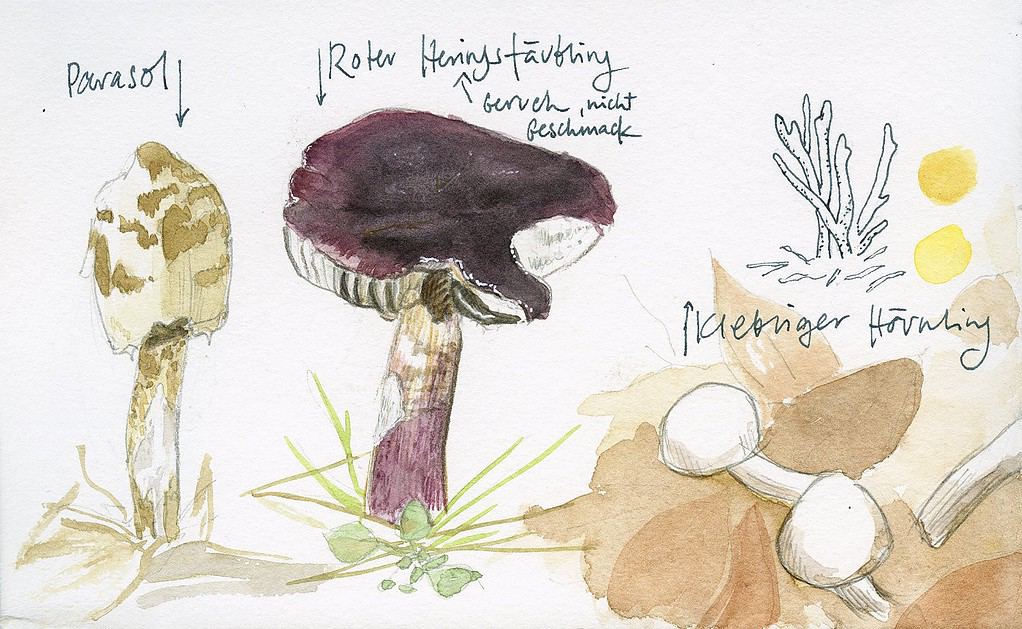
Using colored pencils on top of existing paint layers can sometimes be a bit tricky. I find it works best when the paint underneath is really dry, so you don’t create indentations with the pencil tip. So it’s not the best technique for impatient sketchers (like me). I sometimes destroy parts of my sketches by adding colored pencil too soon. Another factor is that some colors of the same pencil brand can feel a bit more harsh (depending on the pigment and probably on temperature, too), so not every pencil performs the same.
Applying pencil lines first and then going over them with paint doesn’t work always either. As stated above, some colored pencils have so much water-repelling ingredients that the wash goes on in beads. You can usually force a smooth wash over your drawing if you go over it for a few times. Of course watercolor pencils will dissolve easily if you add water. I find that for preserving details under a watercolor wash the Polychromos usually work best (but maybe that’s because I use them the most).
Another interesting effect you can get out of water-soluble pencils drawing on slightly damp paper – it creates a nice texture (wetting the tip and then drawing is not recommended because it can damage the wood and the lead). When using these pencils to achieve a watercolor effect, I find it’s most helpful to apply color first, then blend the area with water, and go over it again with colored pencil when it’s dried. That way, you get a more even color application.
All in all, I really like having colored pencils around for sketching and they’re an essential part of my technique.
How I store and sharpen my colored pencils
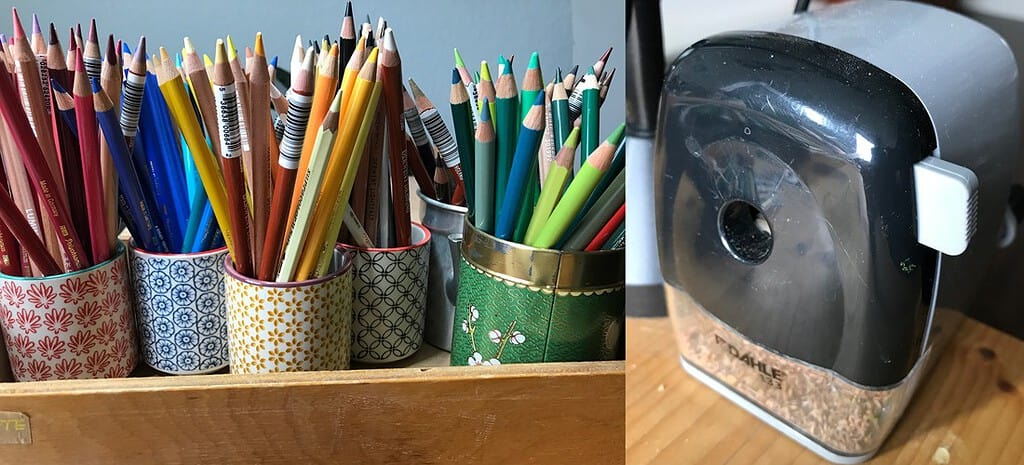
I store my pencils in jars, with the tip pointing up, sorted by color for a bit of every-day-OCD-fun. Most colored pencils also have colored shafts, so it’s no problem picking the one I want very quickly. Some brands (CdA Luminance, all of the Derwents) only have thin color rings on the end, so I have to go by the color of the tip.
One of the best investments in my studio is my Dahle 133 pencil sharpener, which produces excellent tips on all pencils. I avoid small hand sharpener whenever I can.
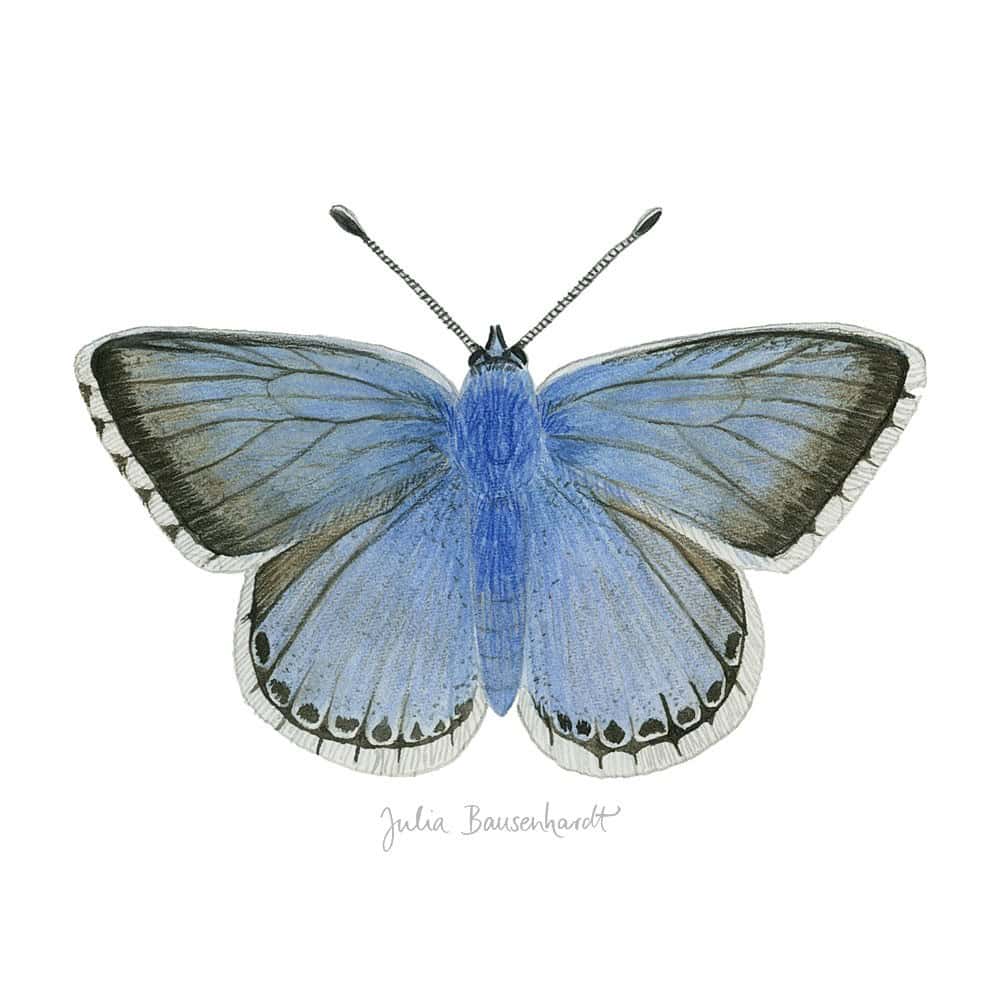
Resources:
Faber-Castell Color Charts
Derwent Color Charts
Caran D’Ache Color Charts – You’ll have to select a product with the colored pencil line to get a PDF with a color chart.
Do you use colored pencils for sketching? Which ones do you like best and how do you use them?

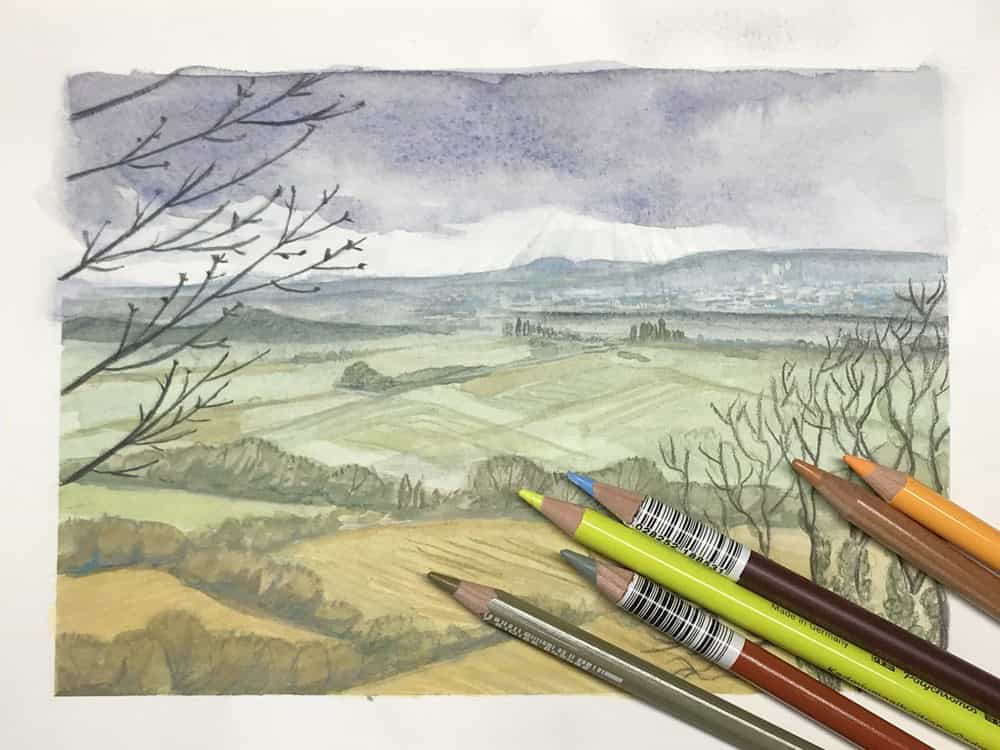

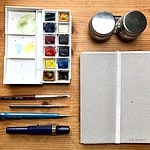
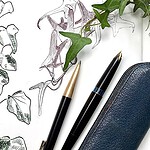
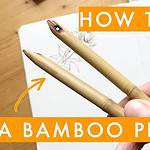
Sehr interessant, wie gewöhnlich. Dankeschön.
Sehr gerne. :-)
Nice post! I recently requested and received a set of caran d’ache luminance colored pencils as a gift, and I must say their waxiness really disappointed me. So my most expensive, “high-quality” pencils are my least favorite! Live and learn. I, too, enjoy using colored pencils in addition to watercolor, for texture and detail.
I know, I felt the same way! I guess they’re great for more traditional colored pencil techniques with a lot of layers and blending, it’s just not what we sketchers need.
Great reminder for me to put in final details with colored pencil! I really like this effect and I learned it from your Skillshare classes (butterflies & mushrooms)! I have Faber-Castell Goldfaber simply because that was what my craft store had but I am really happy with them! One pet peeve is that they only have the color swatch on the end of the pencil, not the whole shaft, and I store my pencils tips up in a holder, so it makes it a little hard to see what color the pencil is! Thanks so much for sharing your colored pencil reviews!
Oh I know that effect, sometimes it’s really hard to pick the right pencil when you can only see the tip. I also tried put soft fabric into my pencil jar to be able to put the pencils in with the tip down, but it didn’t really work well.
I am new to watercolor and I really enjoy it! Now I am anxious to try out colored pencils when I do a sketch that I am going to paint. I have regular colored pencils and also watercolor pencils. This will be fun!
Cherie
I had an idea for storing watercolor pencils upsidedown. Cut a kitchen sponge to fit in the jar. I think that would work.
Thanks for the idea, I’ve already tried a few things bunt this might actually work!
I put a layer of uncooked rice in the bottom of the jar and then put them in tip down. If you use a lot of rice you can accommodate short pencils, and just put the longer one further in.
Hi Julia,
Thanks, I always appreciate your blog posts. It never occurred to me that colored pencils might not be lightfast. I prefer a handheld sharpener over an electric pencil sharpener because the electric one seems to waste more of the colored lead. I tried once wetting the shavings of my watercolor pencils sprinkled on paper. Unfortunately, with so many colors it just turned into a muddy color.
Ah, I should have mentioned that the sharpener isn’t electric, it has a small manual handle at the back. :-) But I agree that one has to be careful not to let the sharpener eat half the pencil.
And I know, I didn’t think about the lightfastness of my colored pencils either, until another artist brought it up. Some colors fade quite fast, it came as a little shock to me.
Wow, very informative and so helpful because I am into colored pencil art at the moment. I like very detailed drawings (you mention OCD, ha). I will save and read your blog again since I am in the process of collecting colored pencils. I use mostly Prismacolor Premier pencils and have a few Polychromos and Luminance also. Thanks for the information and tips.
I’ve never tried Prismacolor, they’re hard to get here. Enjoy your drawings!
Thanks for the info! Sometimes I forget that you can add nice detail/shading with colored pencils. I used your ideas today with Inktense pencils over watercolor. Thanks again!
Inktense pencils are really great for this technique, aren’t they?
Your talent has been inspiring me for a long time. I save all of your email for reference. Thank you so much
Thank you very much Deb, I really appreciate it!
This article came in good time. I have been looking to get some pencils to add to my nature journaling kit. Great to your experience with various options available in the market.
I hope you’ll find colored pencils that suit your techniques and needs! :)
Such beautiful drawings! The butterfly is lovely! Colored pencils remind me of my childhood. Getting a box of Faber-Castell was one of my childhood dreams for a long time. And when I got one, it was heaven!
Thank you and what a lovely story!
I am new to watercolor and I really enjoy it! Now I am anxious to try out colored pencils when I do a sketch that I am going to paint. I have regular colored pencils and also watercolor pencils. This will be fun!
Cherie
That sounds like a good plan indeed. Happy sketching Cherie!
Every time I see you pull out a colored pencil in your videos, I think – OH! You can do that? I’m very much a novice with watercolors and actually using colored pencils too although I have a full color range of them (got frustrated with trying to blend colors to come up with the actual color I was going for). I have to remember this trick of combining the two.
That butterfly, btw, is fantastic!
Yes, you absolutely can do this! I know it’s not the traditional way of layering and blending colored pencils, but I think it brings out the strengths of both mediums. Thank you so much!
I use Prismacolours as well, but this blog post has me thinking I might want to try a few others! I feel that prismacolour falls a bit on the soft side, because a sharp tip will wear, or crumble, quite easily. I do love them, but trying to do crisp lines can be frustrating.
Very interesting about the Prismacolors (they’re hard to get here). I’ve noticed since comparing different types of pencils I choose different ones depending on if I need a crisp line or not.
Hi Julia, thankyou for another interesting blog post. Very useful information as I have just started using my colour pencils combined with Watercolour. Had just been wondering about looking out for a good pencil sharpener. So now I know what to get
Best regards from Harriet in Denmark
You’re wecome Harriet!
That’s so odd- my experience with Caran d’Ache customer service was very different! They are hard to find in my country so after not getting ANY joy with the local art shop I bought them from I emailed Switzerland directly. I got a faulty pencil in a box I waited 8 weeks for…
Caran d’Ache by snail mail fixed it- faulty pencil was replaced along with a bonus pencil blender and a freebie. (Swatched out and protected pencil package in the parcel.) And yes mail from Switzerland took 3 weeks and STILL no response from the local retailer.
I bought Derwent Lightfast while waiting for the delayed Luminance box due a big Lightfast sale. I loved my Museum Aquarelle so thought Luminance would suit. I cannot stand the Derwent Artists so took a risk on their Lightfast. Oh wow am I glad I did, though the 36 pack has some wierd holes in the colour selection. Then my Luminance arrived, same thing. I’m still getting familiar with both but they don’t leave the house.
Prismas are near impossible to find here but Derwent released their version, Chromaflow, which I picked up on a whim. The pencils blend really well. The 24 pack tin is amazing for a travel kit though I don’t think I’ll re-buy after I run them out. (They are hard to find; not cheap vs Prismas; were not available open stock last I checked; and the 24 pack colour selection, the light blues, was odd. Apparently they’ve released 72 but only in the UK now, plus totally changed the numbering system. My Lightfast are better- yes expensive, but you get what you pay for. The purples especially!)
Thanks for your blog, it’s a good diversion from reality at the moment.
I guess with customer service it always depends on the individual you’re dealing with, and I imagine when it’s about a purchase that went wrong they are more inclined to be forthcoming than when they get a random inquiry about detailed information on their pencil lines. ;-)
And of course that says nothing about the quality of the product itself. I’m happy with the few Luminance and Lightfast pencils that I have too, they are very well made, although I will probably only buy again those colors that are hard to find from other brands.
I’m glad to hear you enjoy the blog!